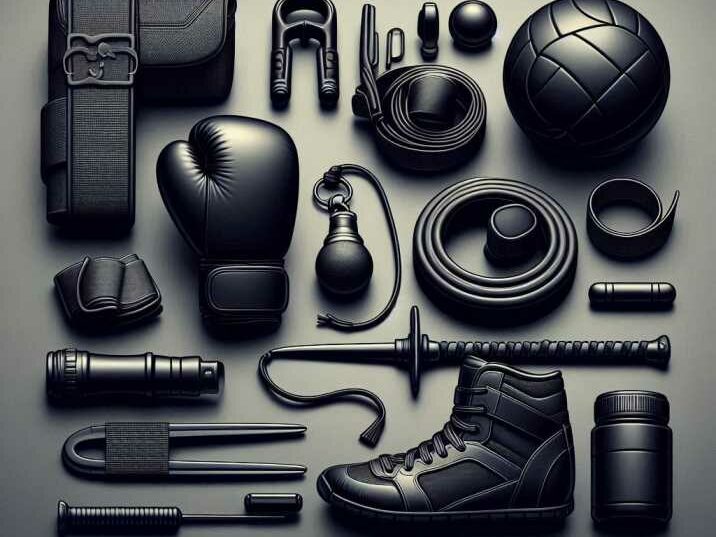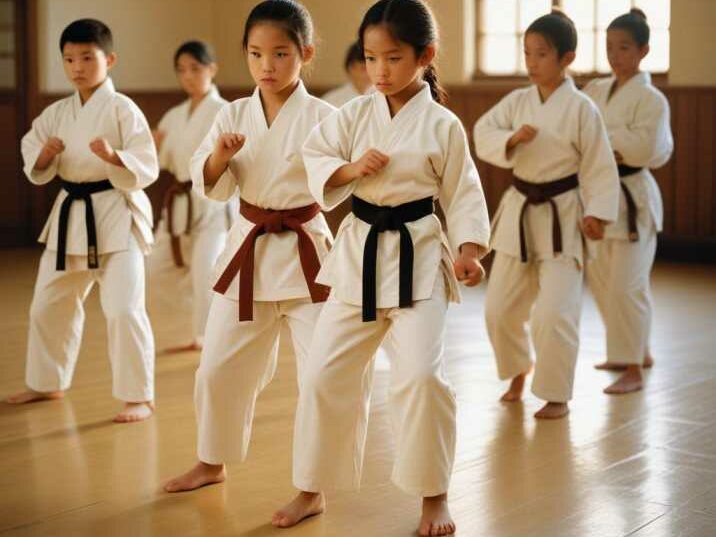When it comes to martial arts training for kids, having the right equipment is essential. Not only does it ensure their safety, but it also enhances their training experience, helping them develop skills and confidence. Here’s a list of essential and high-quality kids Martial Arts training equipment.

kids Martial Arts Training Equipment
Table of Contents
Training Uniforms (Gi)
The martial arts Gi serves as more than just attire; it’s a fundamental piece of training equipment that impacts quality and comfort. When choosing a Gi, several factors are crucial to consider:
Durability: A high-quality Gi features reinforced stitching and strong fabric to withstand the rigors of training, including grappling and repetitive movements. This durability ensures longevity, making it a worthwhile investment for practitioners.
Comfort: Training sessions can be intense, so comfort is key. Look for Gis made from lightweight and breathable materials such as cotton or cotton-blend weaves. These fabrics offer comfort by allowing air circulation and moisture absorption, keeping practitioners cool and dry during training.
Fit: Proper fit is essential for unrestricted movement. Gis come in various sizes and cuts, so finding one that allows for freedom of movement without being too loose or restrictive is important. A well-fitted Gi enhances mobility and comfort, crucial for executing techniques effectively.

Protective Gear
In martial arts, safety should always be a priority, particularly when training, and especially for children. Protective gear plays a crucial role in minimizing the risk of injury during practice. Here’s an overview of essential protective gear:
Headgear: Designed to protect the head and face from impacts, headgear is particularly important in sparring and contact drills. It cushions blows and reduces the risk of cuts, bruises, or more serious head injuries.
Mouthguards: Protecting the teeth and gums, mouthguards are essential for all martial arts practitioners, regardless of age or experience level. They absorb impact forces that could otherwise lead to dental injuries.
Shin Guards: These protect the lower legs, particularly the shin area, during sparring and drills involving kicks and blocks. Shin guards help absorb impact and reduce the risk of painful bruises or more serious injuries to the shins.
Groin Protectors: Vital for both male and female practitioners, groin protectors shield sensitive areas from accidental impacts during training and sparring. They are essential for safety and comfort.
Chest Protectors: These provide an extra layer of protection for the torso, particularly in sports like taekwondo or karate where chest strikes are common. Chest protectors absorb impact and reduce the risk of injury to the ribs and sternum.
Training Pads and Shields
Effective training in martial arts involves honing striking techniques through repetitive drills. Training pads and shields are indispensable tools for both practitioners and instructors:
Focus Mitts: Used by partners or trainers, focus mitts help improve striking accuracy, timing, and technique. They are lightweight and handheld, making them versatile for various drills and combinations.
Kick Pads: Also known as Thai pads or strike shields, kick pads are designed to absorb powerful kicks and strikes. They provide a larger target area than focus mitts, allowing practitioners to practice with full force while minimizing impact on their training partner.
Body Shields: These larger pads are worn by trainers or held against the body, providing a robust target for punches, kicks, and knee strikes. Body shields allow practitioners to practice full-power strikes safely and effectively.
Thai Pads: Originally from Muay Thai but widely used across martial arts disciplines, Thai pads are versatile tools for practicing both kicking and punching combinations. They are larger than focus mitts and offer better protection for the holder against powerful strikes.
4. Training Weapons
Training with weapons is a traditional aspect of many martial arts disciplines, offering practitioners the opportunity to develop coordination, focus, and discipline. Here are some common training weapons used:
Foam Nunchaku: Ideal for beginners, foam nunchaku replicate the traditional wooden nunchaku but with a foam exterior that reduces the risk of injury during practice. They allow practitioners to learn basic techniques without the danger of striking themselves or others accidentally.
Training Bokken: Also known as a wooden sword, the training bokken is used in disciplines like Kendo, Aikido, and Kenjutsu for practicing forms (kata) and techniques. Made from durable wood, it provides a realistic weight and feel while minimizing the risk of injury compared to live blades.
Staffs (Bo): The Bo staff is a versatile weapon found in various martial arts such as Karate, Kung Fu, and Kobudo. Training staffs are typically lightweight and may have padded ends for safety. They help practitioners develop strength, agility, and precision in striking and blocking techniques.
5. Training Mats
Training mats are essential for creating a safe environment where martial artists can practice techniques with reduced risk of injury:
Puzzle Mats: These interlocking mats are popular in martial arts dojos and home training spaces due to their ease of assembly and versatility. Puzzle mats provide cushioning against impacts, making them ideal for grappling, rolling, and groundwork training. They are available in various thicknesses to suit different martial arts disciplines.
Tatami Mats: Traditionally used in Japanese martial arts such as Judo and Aikido, tatami mats offer excellent grip and shock absorption. They provide a firm yet forgiving surface that mimics traditional dojo flooring, enhancing stability and preventing slips during training. Tatami mats are durable and often used in competition settings as well as for everyday practice.
6. Resistance Bands
Incorporating resistance bands into martial arts training enhances strength, flexibility, and muscle endurance. Here’s why they are beneficial:
Light, Medium, Heavy Bands: Resistance bands come in varying levels of resistance, allowing practitioners to tailor their workouts to different muscle groups and fitness levels. This versatility makes them suitable for both beginners and advanced martial artists looking to improve strength and flexibility.
Versatility: Resistance bands can be used for a wide range of exercises, including strengthening the core, improving joint stability, and enhancing kicking and punching techniques. They provide constant tension throughout each movement, helping to build muscle tone and endurance effectively.
4. Training Dummies
Training dummies are invaluable tools in martial arts training, offering practitioners a way to practice techniques, strikes, and throws effectively on their own. Here are two common types of training dummies:
Standing Dummies: Standing dummies are typically life-sized and designed to simulate a human body. They are used for a variety of training purposes:
- Striking Practice: Practitioners can work on their punching and kicking techniques, aiming at specific targets such as the head, torso, or limbs of the dummy. This allows for repetitive practice of strikes with proper form and accuracy.
- Throwing Techniques: Some standing dummies are designed with jointed limbs or movable parts that allow for practicing throws and joint locks. This is especially beneficial for martial arts styles that involve grappling and throwing techniques, such as Judo or Brazilian Jiu-Jitsu.
- Conditioning: By repeatedly striking a standing dummy, martial artists can condition their hands, feet, and shins for impact, helping to develop strength and resilience in their striking abilities.
Standing dummies are versatile and can be adjusted or customized with additional padding or attachments to suit different training needs and martial arts styles.
Hanging Bags: Hanging bags are large, heavy bags suspended from the ceiling or a sturdy frame. They are primarily used for striking practice:
- Powerful Strikes: Hanging bags are ideal for practicing powerful kicks, punches, elbows, and knees. The weight and resistance of the bag provide feedback and resistance, helping practitioners develop strength, power, and technique in their strikes.
- Endurance Training: Continuous striking of a hanging bag helps improve endurance and stamina, as practitioners work on maintaining consistent power and speed throughout their training sessions.
- Impact Absorption: The padding and filling inside hanging bags absorb the impact of strikes, reducing the risk of injury to the practitioner’s hands and feet while allowing them to practice with intensity.
Hanging bags come in various sizes and shapes, including heavy bags for general striking practice and specialty bags like Muay Thai banana bags or speed bags for specific training purposes.
5. Belts and Sashes
In martial arts, belts and sashes serve not only as practical components of the uniform but also as symbols of rank and progression. Here’s what you should consider about belts and sashes:
- Material: Belts and sashes are typically made from strong, durable materials such as cotton or polyester. These materials are chosen for their ability to withstand regular wear and washing without losing color or integrity, ensuring longevity and reliability throughout a practitioner’s journey.
- Length and Color: The length and color of belts and sashes correspond to the wearer’s rank or level within their martial arts discipline. Different martial arts have specific systems for belt colors and rankings, with each color representing a different stage of proficiency and accomplishment.
- Symbolism: Belts and sashes hold significant symbolism in martial arts culture, signifying not only technical skill but also personal growth, discipline, and dedication to the art. Advancing to a higher belt or sash color reflects a practitioner’s progress in mastering techniques, principles, and values associated with their martial art.
- Cultural Significance: Beyond their practical and symbolic roles, belts and sashes often carry cultural significance, reflecting the traditions and heritage of the martial art. They serve as visual indicators of respect, honor, and commitment within the martial arts community.
Conclusion
Equipping your child with the right martial arts training gear can make a significant difference in their learning experience and safety. Investing in high-quality equipment not only protects them but also fosters a love for the sport. Ready to gear up? Check out our collection of kids’ martial arts training equipment and take the first step towards mastering the martial arts.
Call to Action: Explore our range of kids’ martial arts training equipment now and start your child’s martial arts journey on the right foot!
FAQs
- What type of Gi is best for kids just starting martial arts?
- For beginners, a lightweight cotton or cotton-blend Gi is recommended. It should be durable with reinforced stitching to withstand initial training sessions, and comfortable enough to allow ease of movement.
- Is protective gear necessary for young martial artists?
- Yes, protective gear such as headgear, mouthguards, shin guards, and chest protectors are essential to ensure safety during training and minimize the risk of injuries.
- How do I choose the right size training pads and shields for my child?
- Training pads and shields come in various sizes. Choose smaller, lightweight focus mitts and kick pads for younger children to ensure they can handle and maneuver them easily during practice.
- Are resistance bands safe for children to use in martial arts training?
- Yes, resistance bands are safe when used under supervision and with proper instruction. They are excellent for enhancing strength and flexibility without putting excessive strain on young muscles and joints.
- What is the importance of belts and sashes in martial arts for kids?
- Belts and sashes signify a student’s rank and progress. They provide a sense of achievement and motivation for young martial artists, encouraging them to advance and develop their skills further.


